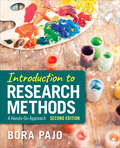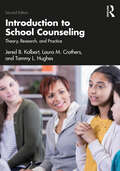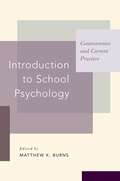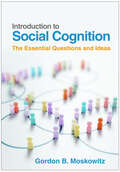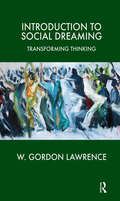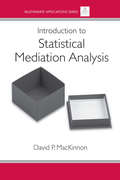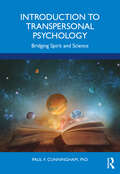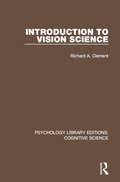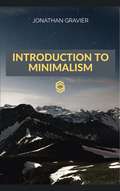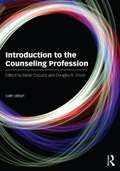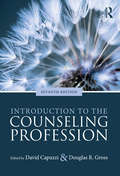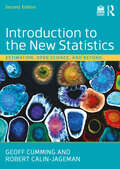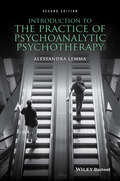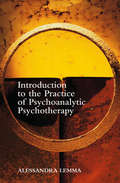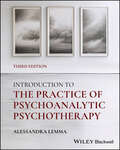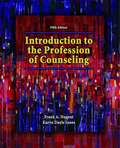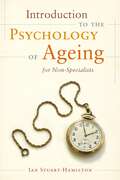- Table View
- List View
Introduction to Research Methods: A Hands-on Approach
by Bora PajoThe Second Edition of Introduction to Research Methods: A Hands-On Approach by Bora Pajo continues to make research easy to understand and easy to construct. Covering both quantitative and qualitative methods, this new edition lays out the differences between research approaches so readers can better understand when and how to use each research design. Through clear, simple, and even humorous prose, this text offers students a straightforward introduction to a new world of social science research. Rather than making research seem intimidating, Introduction to Research Methods shows students that research is an ongoing conversation concerning topics that matter in their lives, a conversation that′s easy to understand and easy to join. The new edition features updated chapters on qualitative designs and qualitative data analysis, a new chapter on big data and digital methods, and updated citation and report styles for APA Style 7th Edition. This title is accompanied by a complete teaching and learning package in SAGE Vantage, an intuitive learning platform that integrates quality SAGE textbook content with assignable multimedia activities and auto-graded assessments to drive student engagement and ensure accountability. Unparalleled in its ease of use and built for dynamic teaching and learning, Vantage offers customizable LMS integration and best-in-class support.
Introduction to Research Methods: A Hands-on Approach
by Bora PajoThe Second Edition of Introduction to Research Methods: A Hands-On Approach by Bora Pajo continues to make research easy to understand and easy to construct. Covering both quantitative and qualitative methods, this new edition lays out the differences between research approaches so readers can better understand when and how to use each research design. Through clear, simple, and even humorous prose, this text offers students a straightforward introduction to a new world of social science research. Rather than making research seem intimidating, Introduction to Research Methods shows students that research is an ongoing conversation concerning topics that matter in their lives, a conversation that′s easy to understand and easy to join. The new edition features updated chapters on qualitative designs and qualitative data analysis, a new chapter on big data and digital methods, and updated citation and report styles for APA Style 7th Edition. This title is accompanied by a complete teaching and learning package in SAGE Vantage, an intuitive learning platform that integrates quality SAGE textbook content with assignable multimedia activities and auto-graded assessments to drive student engagement and ensure accountability. Unparalleled in its ease of use and built for dynamic teaching and learning, Vantage offers customizable LMS integration and best-in-class support.
Introduction to Safety Science: People, Organisations, and Systems (Transportation Human Factors)
by David Peter O'HareThe book is designed as an accessible and readable introduction to a rapidly expanding area that is in demand worldwide. A variety of professionals from different backgrounds are being tasked with managing health and safety risks in a wide variety of settings. Many lack current and up-to-date knowledge of the key developments that have taken place in Safety Science in recent decades, as well as a sense of how these developments fit in with previous approaches. This book takes readers on a ‘journey’ across three broad developments in safety science. It covers topics that focus on the individual including human error, risk and the role of cognition in human performance. It then shifts to research in safety science that uses organizations as the basic unit of analysis, questions about organizational decision making and the characteristics that dispose towards or against organizational failure and it introduces perspectives based on systems science that address issues that arise out of complexity and interdependence. Those who will purchase this book are students taking courses in human factors, ergonomics, applied psychology, occupational health and safety management. Professionals working in safety management in any field from agriculture, construction, shipping, aviation, power generation, oil exploration, manufacturing to healthcare will find this book useful, as well as general readers interested in why systems fail.
Introduction to School Counseling: Theory, Research, and Practice
by Laura M. Crothers Jered B. Kolbert Tammy L. HughesThis book is a comprehensive introduction to the profession for school counselors in training, providing special focus on the topics most relevant to the school counselor’s role, and offers specific strategies for practical application and implementation. In addition to the thorough coverage of the fourth edition of the ASCA National Model, readers will find thoughtful discussions of the effects of trends and legislation, including the Every Student Succeeds Act (ESSA), multitiered systems of support (MTSS), and school-wide positive behavioral interventions and supports (SWPBIS). The text also provides readers with understanding of how school counselors assume a counseling orientation within the specific context of an educational setting. Each chapter is application-oriented, with an equal emphasis both on research and on using data to design and improve school counselors’ functioning in school systems. Complementing this book is the companion website, which includes PowerPoints, templates and handouts, annotated website links and video links for students, and a test bank and discussion questions for instructors. This book is essential reading for all school counselors in training as it provides a comprehensive look at the profession and explores topics that are most relevant to the role of school counselor.
Introduction to School Psychology: Controversies and Current Practice
by Matthew K. BurnsThe discipline of school psychology has been shaped over the course of its existence by a series of professional and scientific controversies, and by how researchers and practitioners have responded to those controversies. Should there be an entry-level degree requirement for school psychologists? What should a school psychologist's role be with regard to student mental health? Should school psychologists work outside of school settings? Designed for students entering school psychology training programs, Introduction to School Psychology: Controversies and Current Practice examines the debates that have influenced the nature and scope of the profession, and that continue to do so today. This edited textbook is divided into five sections, the first of which describes current practices. The second offers coverage of ethics and relevant legal concerns for school psychologists; cultural competence; and consultation. The third section provides readers with the theoretical foundations of practice and includes a brief chapter on theoretical orientations. The fourth and largest section of the book examines the controversies that shape practice, presenting chapters on idiographic and nomothetic approaches; diagnostic frameworks; assessment and treatment of behavioral disorders; and much more. The final section of the book focuses on contexts and the future of the profession, with chapters on practice in urban and rural communities, technology, and the Futures Conferences.
Introduction to Social Cognition: The Essential Questions and Ideas
by Gordon B. MoskowitzWhy are first impressions so powerful? How do we &“know&” what others are like when we cannot read their minds? How can scientists measure biases that people do not want to admit--or do not know they have? This engaging text delves into social cognition by exploring major questions in the field through an everyday lens. Students are introduced to core concepts and processes pertaining to how people come to know themselves and understand the behavior of others. Classic and contemporary findings and experimental methods are explained. The text connects the research to pressing contemporary problems--the roots of political polarization, why even rational people fall prey to misinformation, and the best ways to reduce prejudice. Boxed definitions of key terms are included throughout.
Introduction to Social Dreaming: Transforming Thinking
by W. Gordon LawrenceThis book explains social dreaming by situating it in the context of thinking, culture, and knowledge and distinguishes how it differs from conventional, therapeutic dreaming, making the case for how it can be used in systems, like business organizations, educational institutions, and hospitals.
Introduction to Social Neuroscience
by John T. Cacioppo Stephanie CacioppoA textbook that lays down the foundational principles for understanding social neuroscienceHumans, like many other animals, are a highly social species. But how do our biological systems implement social behaviors, and how do these processes shape the brain and biology? Spanning multiple disciplines, Introduction to Social Neuroscience seeks to engage students and scholars alike in exploring the effects of the brain’s perceived connections with others. This wide-ranging textbook provides a quintessential foundation for comprehending the psychological, neural, hormonal, cellular, and genomic mechanisms underlying such varied social processes as loneliness, empathy, theory-of-mind, trust, and cooperation.Stephanie and John Cacioppo posit that our brain is our main social organ. They show how the same objective relationship can be perceived as friendly or threatening depending on the mental states of the individuals involved in that relationship. They present exercises and evidence-based findings readers can put into practice to better understand the neural roots of the social brain and the cognitive and health implications of a dysfunctional social brain. This textbook’s distinctive features include the integration of human and animal studies, clinical cases from medicine, multilevel analyses of topics from genes to societies, and a variety of methodologies.Unveiling new facets to the study of the social brain’s anatomy and function, Introduction to Social Neuroscience widens the scientific lens on human interaction in society.The first textbook on social neuroscience intended for advanced undergraduates and graduate studentsChapters address the psychological, neural, hormonal, cellular, and genomic mechanisms underlying the brain’s perceived connections with othersMaterials integrate human and animal studies, clinical cases, multilevel analyses, and multiple disciplines
Introduction to Statistical Mediation Analysis (Multivariate Applications Ser.)
by David MacKinnonThis volume introduces the statistical, methodological, and conceptual aspects of mediation analysis. Applications from health, social, and developmental psychology, sociology, communication, exercise science, and epidemiology are emphasized throughout. Single-mediator, multilevel, and longitudinal models are reviewed. The author's goal is to help the reader apply mediation analysis to their own data and understand its limitations. Each chapter features an overview, numerous worked examples, a summary, and exercises (with answers to the odd numbered questions). The accompanying CD contains outputs described in the book from SAS, SPSS, LISREL, EQS, MPLUS, and CALIS, and a program to simulate the model. The notation used is consistent with existing literature on mediation in psychology. The book opens with a review of the types of research questions the mediation model addresses. Part II describes the estimation of mediation effects including assumptions, statistical tests, and the construction of confidence limits. Advanced models including mediation in path analysis, longitudinal models, multilevel data, categorical variables, and mediation in the context of moderation are then described. The book closes with a discussion of the limits of mediation analysis, additional approaches to identifying mediating variables, and future directions. Introduction to Statistical Mediation Analysis is intended for researchers and advanced students in health, social, clinical, and developmental psychology as well as communication, public health, nursing, epidemiology, and sociology. Some exposure to a graduate level research methods or statistics course is assumed. The overview of mediation analysis and the guidelines for conducting a mediation analysis will be appreciated by all readers.
Introduction to Theories of Learning: Ninth Edition
by Matthew H. OlsonDefines learning and shows how the learning process is studied. Clearly written and user-friendly, Introduction to the Theories of Learning places learning in its historical perspective and provides appreciation for the figures and theories that have shaped 100 years of learning theory research. The 9th edition has been updated with the most current research in the field. With Pearson's MySearchLab with interactive eText and Experiment's Tool, this program is more user-friendly than ever. Learning Goals Upon completing this book, readers should be able to: Define learning and show how the learning process is studied Place learning theory in historical perspective Present essential features of the major theories of learning with implications for educational practice Note: MySearchLab does not come automatically packaged with this text. To purchase MySearchLab, please visit: www.mysearchlab.com or you can purchase a ValuePack of the text + MySearchLab (at no additional cost).
Introduction to Theory-Driven Program Evaluation: Culturally Responsive and Strengths-Focused Applications
by Stewart I. DonaldsonIntroduction to Theory-Driven Program Evaluation provides a clear guide for practicing evaluation science, and numerous examples of how these evaluations actually unfold in contemporary practice. A special emphasis is placed how to conduct theory-driven program evaluations that are culturally responsive and strengths-focused. In this thoroughly revised new edition, author Stewart I. Donaldson provides a state-of-the art treatment of the basics of conducting theory-driven program evaluations. Each case follows a three-step model: developing program impact theory; formulating and prioritizing evaluation questions; and answering evaluation questions. The initial chapters discuss the evolution and popularity of theory-driven program evaluation, as well as step-by-step guide for culturally responsive and strengths-focused applications. Succeeding chapters provide actual cases and discuss the practical implications of theory-driven evaluation science. Reflections, challenges, and lessons learned across numerous cases from practices are discussed. The volume is of significant value to practicing evaluators, professors of introductory evaluation courses and their students, advanced undergraduate and graduate students, and serves as a text or a supplementary text for a wide range of evaluation and applied research courses. It is also of great interest to those interested in the connections between work and health, well-being, career development, human service organizations, and organizational improvement and effectiveness.
Introduction to Transpersonal Psychology: Bridging Spirit and Science
by Paul F. Cunningham, Ph.D.Introduction to Transpersonal Psychology: Bridging Spirit and Science provides an accessible and engaging introduction to this complex and evolving field. Adopting a modular approach, the book systematically relates key themes of Transpersonal Psychology to three major areas within psychology: general psychology, experimental psychology, and clinical psychology. Covering a wide range of topics including transpersonal states of consciousness, biological foundations, research methods, and cognition, the book also features extensive discussion of transpersonal theorists and the impact of their work on our understanding of psychological concepts. The book also introduces contemporary developments in the field and anticipates future advances such as feminist perspectives and cross-cultural approaches alongside practical experiments designed to give transpersonal theories and concepts psychological roots. A critical evaluation of both mainstream and transpersonal theories and research is applied throughout to foster analytical skills and encourage critical and scientific thinking about humanity’s nature as spiritual creatures and ways to educate for personal and social transformation. Accompanied by an online instructor’s manual, this book will be an essential companion for all students of Transpersonal or Humanistic Psychology, or those interested in applying transpersonal ideas to mainstream psychological research.
Introduction to Uncertainty Quantification
by T. J. SullivanThis text provides a framework in which the main objectives of the field of uncertainty quantification (UQ) are defined and an overview of the range of mathematical methods by which they can be achieved. Complete with exercises throughout, the book will equip readers with both theoretical understanding and practical experience of the key mathematical and algorithmic tools underlying the treatment of uncertainty in modern applied mathematics. Students and readers alike are encouraged to apply the mathematical methods discussed in this book to their own favorite problems to understand their strengths and weaknesses, also making the text suitable for a self-study. Uncertainty quantification is a topic of increasing practical importance at the intersection of applied mathematics, statistics, computation and numerous application areas in science and engineering. This text is designed as an introduction to UQ for senior undergraduate and graduate students with a mathematical or statistical background and also for researchers from the mathematical sciences or from applications areas who are interested in the field. T. J. Sullivan was Warwick Zeeman Lecturer at the Mathematics Institute of the University of Warwick, United Kingdom, from 2012 to 2015. Since 2015, he is Junior Professor of Applied Mathematics at the Free University of Berlin, Germany, with specialism in Uncertainty and Risk Quantification.
Introduction to Vision Science (Psychology Library Editions: Cognitive Science)
by Richard A. ClementDifferent animals have different visual systems and so presumably have different ways of seeing. How does the way in which we see depend on the optical, neural and motor components of our visual systems? Originally published in 1993, the mathematical tools needed to answer this question are introduced in this book. Elementary linear algebra is used to describe the transformations of the stimulus that occur in the formation of the optical, neural and motor images in the human visual system. The distinctive feature of the approach is that transformations are specified with enough rigour for readers to be able to set up their own models and generate predictions from them. Underlying the approach of this book is the goal of providing a self-contained source for the derivation of the basic equations of vision science. An introductory section on vector and matrix algebra covers the mathematical techniques which are applied to both sensory and motor aspects of the visual system, and the intervening steps in the mathematical arguments are given in full, in order to make the derivation of the equations easier to follow. A subsidiary goal of this book is to demonstrate the utility of current desktop computer packages which make the application of mathematics very easy. All the numerical results were produced using only a spreadsheet or mathematics package, and example calculations are included in the text.
Introduction to Vygotsky
by Harry DanielsThis thoroughly updated third edition provides students with an accessible overview of Vygotsky’s work, combining reprints of key journal and text articles with rich editorial commentary. Lev Vygotsky provided the twentieth century with an enticing mix of intellectual traditions within an attempt to provide an account of the social formation of the mind. His legacy is an exciting, but at times challenging fusion of ideas. Retaining a multi-disciplinary theme, Introduction to Vygotsky, 3rd edition begins with a review of current interpretations of Vygotksy’s original work. Harry Daniels goes on to consider the development of Vygotsky’s work against a backdrop of political turmoil in the developing USSR. Major elements explored within the volume include the use of the 'culture' concept in social development theory, the development of means of describing social life, the concept of mediation, and implications for teaching, learning and assessment This book will be essential reading for Vygotskian students in developmental psychology, education and social sciences, as well as to students on specialised courses on cultural, cross-cultural and socio-cultural psychology, philosophical psychology, philosophy of science, history of psychology and Soviet/Russian history.
Introduction to minimalism
by Jonathan Gravier"Whether we call ourselves Minimalist or not, we all seek a better life. Also, it is possible to achieve a balanced view and just beyond our illusory conditions and thoughts." By "minimalism", the author does not only mean a fad linked to personal development, but rather a vital, interdependent movement towards serenity with ourselves and others. What is Minimalism? What does it mean to be a Minimalist? What is not Minimalism? How do we relate to money and material goods?
Introduction to the Counseling Profession
by David Capuzzi Douglas R. GrossIntroduction to the Counseling Profession is a comprehensive overview of the history and foundational concepts of counseling, offering the most current and relevant breadth of coverage available. Students will gain insight into the myriad issues that surround not only the process of counseling and its many populations but also the personal dynamics that have an impact on this process. The contributed-author format provides state-of-the-art information from experts in their respective fields while maintaining a consistent structure and message. This edition has been brought in line with the 2009 Council for the Accreditation of Counseling and Related Educational Programs (CACREP) standards and includes chapters on each of the CACREP specializations. Topics rarely treated in other introductory texts are addressed, such as research and writing in counseling, technology and counseling, and self-care and growth. This edition includes new pedagogical features such as sidebars and more case studies to expand on key topics, as well as new chapters on: Cross-Cultural Counseling Self-Care and Self-Growth Individual Counseling Diagnosis and Treatment Planning Addictions Counseling Student Affairs and College Counseling A collection of supplemental resources are available online to benefit both instructors and students. Instructors will find PowerPoint slides and test banks to aid in conducting their courses, and students can access chapter summaries, exercises, and other tools to supplement their review of the material in the text. These materials can be accessed at http://www.routledgementalhealth.com/cw/Capuzzi
Introduction to the Counseling Profession
by David Capuzzi Douglas R. GrossDesigned for students who are taking a preliminary course in the counseling field, Introduction to the Counseling Profession, 7th Edition, provides a comprehensive overview of the history and foundational concepts of counseling, offering the most current and relevant breadth of coverage available from experts in their respective fields. This edition includes topics rarely discussed in introductory texts, such as self-care and self-growth and the use of technology in counseling, as well as a new chapter on crisis counseling. Chapters also reflect updates to the 2016 Council for the Accreditation of Counseling and Related Educational Programs (CACREP) standards, and a chapter on each CACREP specialization is included. Students will gain insight into the myriad issues that surround not only the process of counseling and its many populations but also the personal dynamics that have an impact on this process. Furthermore, a collection of supplemental resources is available online to benefit both instructors and students. Instructors will find PowerPoint slides and test banks to aid in conducting their courses, and students can access chapter summaries, exercises, and other tools to supplement their review of the material in the text.
Introduction to the New Statistics: Estimation, Open Science, and Beyond
by Geoff Cumming Robert Calin-JagemanThis is the first introductory statistics text to use an estimation approach from the start to help readers understand effect sizes, confidence intervals (CIs), and meta-analysis (‘the new statistics’). It is also the first text to explain the new and exciting Open Science practices, which encourage replication and enhance the trustworthiness of research. In addition, the book explains NHST fully so students can understand published research. Numerous real research examples are used throughout. The book uses today’s most effective learning strategies and promotes critical thinking, comprehension, and retention, to deepen users’ understanding of statistics and modern research methods. The free ESCI (Exploratory Software for Confidence Intervals) software makes concepts visually vivid, and provides calculation and graphing facilities. The book can be used with or without ESCI. Other highlights include: - Coverage of both estimation and NHST approaches, and how to easily translate between the two. - Some exercises use ESCI to analyze data and create graphs including CIs, for best understanding of estimation methods. -Videos of the authors describing key concepts and demonstrating use of ESCI provide an engaging learning tool for traditional or flipped classrooms. -In-chapter exercises and quizzes with related commentary allow students to learn by doing, and to monitor their progress. -End-of-chapter exercises and commentary, many using real data, give practice for using the new statistics to analyze data, as well as for applying research judgment in realistic contexts. -Don’t fool yourself tips help students avoid common errors. -Red Flags highlight the meaning of "significance" and what p values actually mean. -Chapter outlines, defined key terms, sidebars of key points, and summarized take-home messages provide a study tool at exam time. -http://www.routledge.com/cw/cumming offers for students: ESCI downloads; data sets; key term flashcards; tips for using SPSS for analyzing data; and videos. For instructors it offers: tips for teaching the new statistics and Open Science; additional homework exercises; assessment items; answer keys for homework and assessment items; and downloadable text images; and PowerPoint lecture slides. Intended for introduction to statistics, data analysis, or quantitative methods courses in psychology, education, and other social and health sciences, researchers interested in understanding the new statistics will also appreciate this book. No familiarity with introductory statistics is assumed.
Introduction to the New Statistics: Estimation, Open Science, and Beyond
by Geoff Cumming Robert Calin-JagemanThis fully revised and updated second edition is an essential introduction to inferential statistics. It is the first introductory statistics text to use an estimation approach from the start and also to explain the new and exciting Open Science practices, which encourage replication and enhance the trustworthiness of research. The estimation approach, with meta-analysis (“the new statistics”), is exactly what’s needed for Open Science.Key features of this new edition include: Even greater prominence for Open Science throughout the book. Students easily understand basic Open Science practices and are guided to use them in their own work. There is discussion of the latest developments now being widely adopted across science and medicine. Integration of new open-source esci (Estimation Statistics with Confidence Intervals) software, running in jamovi. This is ideal for the book and extends seamlessly to what’s required for more advanced courses, and also by researchers. See www.thenewstatistics.com/itns/esci/jesci/. Colorful interactive simulations, including the famous dances, to help make key statistical ideas intuitive. These are now freely available through any browser. See www.esci.thenewstatistics.com/. Coverage of both estimation and null hypothesis significance testing (NHST) approaches, with full guidance on how to translate between the two. Effective learning strategies and pedagogical features to promote critical thinking, comprehension and retention Designed for introduction to statistics, data analysis, or quantitative methods courses in psychology, education, and other social and health sciences, researchers interested in understanding Open Science and the new statistics will also appreciate this book. No familiarity with introductory statistics is assumed.A comprehensive website offers data sets, key term flashcards, learning guides, and videos describing key concepts and demonstrating the use of esci. For instructors, there are guides for teaching the new statistics and Open Science, assessment exercises, question banks, downloadable slides, and more. Altogether, the website provides engaging learning resources for traditional or flipped classrooms. See www.routledge.com/cw/cumming.
Introduction to the Practice of Psychoanalytic Psychotherapy
by Alessandra LemmaA clear and thorough introduction to techniques and practice issues, as well as basic theoretical frameworks, for beginners. Psychoanalysis is not so much skill-based, as dependent upon the development of the analytic attitude, guided by principles of technique that are used in the clinical situation.Alessandra Lemma's accessible guide has been based on her long experience of teaching trainee practitioners. It includes discussion of interventions and the possible dynamics associated with the different stages of therapy: assessment, beginnings, middle and end phases of therapy. It exposes the rationale underlying a range of interventions and discusses research evidence where relevant and available.* Written by a well known author with plenty of practical experience* Introductory and aimed at trainees* Uniquely, it combines practical advice with theoretical explanation
Introduction to the Practice of Psychoanalytic Psychotherapy
by Alessandra LemmaA clear and thorough introduction to techniques and practice issues, as well as basic theoretical frameworks, for beginners. Psychoanalysis is not so much skill-based, as dependent upon the development of the analytic attitude, guided by principles of technique that are used in the clinical situation. Alessandra Lemma's accessible guide has been based on her long experience of teaching trainee practitioners. It includes discussion of interventions and the possible dynamics associated with the different stages of therapy: assessment, beginnings, middle and end phases of therapy. It exposes the rationale underlying a range of interventions and discusses research evidence where relevant and available. Written by a well known author with plenty of practical experience Introductory and aimed at trainees Uniquely, it combines practical advice with theoretical explanation
Introduction to the Practice of Psychoanalytic Psychotherapy
by Alessandra LemmaAn essential guide to psychoanalytic psychotherapy in modern practice. A must-have for those new to the field and seasoned professionals alike Introduction to the Practice of Psychoanalytic Psychotherapy provides up-to-date, practice-oriented coverage of the latest research and techniques in psychoanalysis. Distinguished clinical psychologist and psychoanalyst Alessandra Lemma synthesizes decades of clinical experience and the latest research into actionable advice for developing analytic skills with clarity, confidence, and adaptability across diverse therapeutic settings. This popular textbook offers step-by-step guidance on essential areas of practice, including conducting assessments, formulating cases, and navigating therapeutic endings. Throughout the book, detailed yet accessible chapters demystify the processes behind psychoanalytic psychotherapy while offering real-world insights into the day-to-day practice of psychoanalytic therapy. Fully revised to reflect contemporary practice, this edition features three entirely new chapters on psychoanalytic ethics, working with the body, and online therapy. Updated and expanded chapters address new developments in Dynamic Interpersonal Therapy (DIT), discuss the current evidence base for psychoanalytic interventions, present new case studies and illustrative examples, and more. “Very few psychoanalysts are capable of what Alessandra Lemma achieves with this book: a deep understanding of the life of the mind coupled with a comfortable familiarity with the science of the mind.” —MARK SOLMS, Ph.D., Editor, The Revised Standard Edition of the Complete Psychological Works of Sigmund Freud (2024). “A third edition of this classic text is testimony to how well the original edition was written. Yet it also demonstrates that psychoanalytic therapy and the contexts in which it is practiced are in continual flux. To explain these changes and offer new updates there is no better guide than Alessandra Lemma. She has been at the forefront of many developments and has endeavoured to make psychoanalytic ideas and techniques relevant for the decade that lies ahead. This is a highly readable, enjoyable, and insightful book that deserves to be read again and again. There is always something fresh to discover.” — DR. ALISTAIR ROSS, Associate Professor in Psychotherapy, Kellogg College, Author of Introducing Contemporary Psychodynamic Counselling and Psychotherapy “There are many things to cherish about Alessandra Lemma’s Introduction to the Practice of Psychoanalytic Psychotherapy. Now appearing in its third edition, Lemma exemplifies a mentality that psychoanalysis is alive and kicking—and evolving. The book is especially candid in acknowledging how psychoanalysis, which began ahead of the social curve, but then began to lag behind, is now making up for lost time. It is a pleasure to encounter readings of Freud that are neither adulating nor deprecating, and it is even more of a pleasure to consider this version of contemporary psychoanalysis. Lemma’s work on integrating the body in psychoanalytic theory is well-known and is now incorporated into this book. In addition, Lemma addresses profound ethical issues that we have faced during the pandemic and in its aftermath. Clinicians at every stage of their careers will benefit from reading and reflecting on this terrific book.” — ELLIOT L. JURIST, Ph.D., Ph.D., Professor, Psychology and Philosophy, The City College of New York and Doctoral Faculty in Psychology and in Philosophy, The Graduate Center, The City University of NY
Introduction to the Profession of Counseling
by Frank A. Nugent; Karyn Dayle JonesThis book presents a comprehensive introduction to professional counseling, a profession that helps individuals, groups, and families work through troubles arising from problems experienced in everyday life. As with previous editions, this text's philosophical and theoretical orientation to counseling is based on a phenomenological, psychosocial, life-span developmental approach. In this approach counselors help persons resolve or work through situational, developmental transitions and conflicts within a multicultural context.
Introduction to the Psychology of Ageing for Non-Specialists
by Ian Stuart-HamiltonWhether you provide care for older people, or you are simply interested in ageing, this complete primer on the psychology of ageing explains the key issues clearly and concisely. Beginning with explanations of ageing, life expectancy and demographics, it goes on to discuss the aspects of ageing that have the most impact on people's lives. From changes in intelligence and personality to mental health and sexuality, the author explains the psychology involved and focuses on the points that have most impact on people's lives. Drawing on the latest findings in the field, the book provides a comprehensive overview of the subject. The book will be a key resource for anyone interested in what happens as we age, as well as social workers, care workers, nurses, medical professionals.
